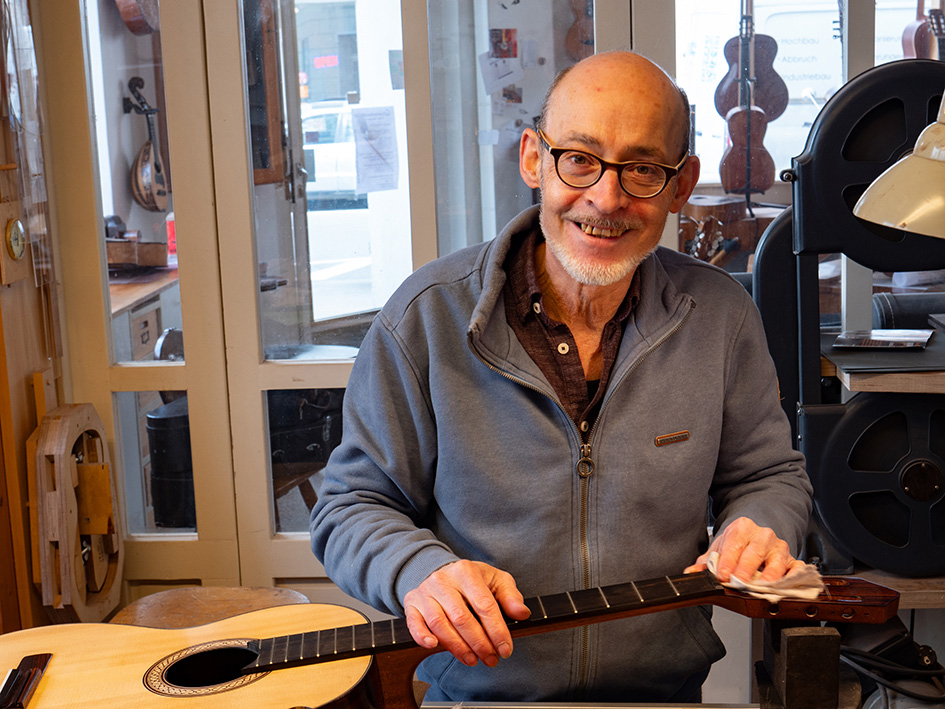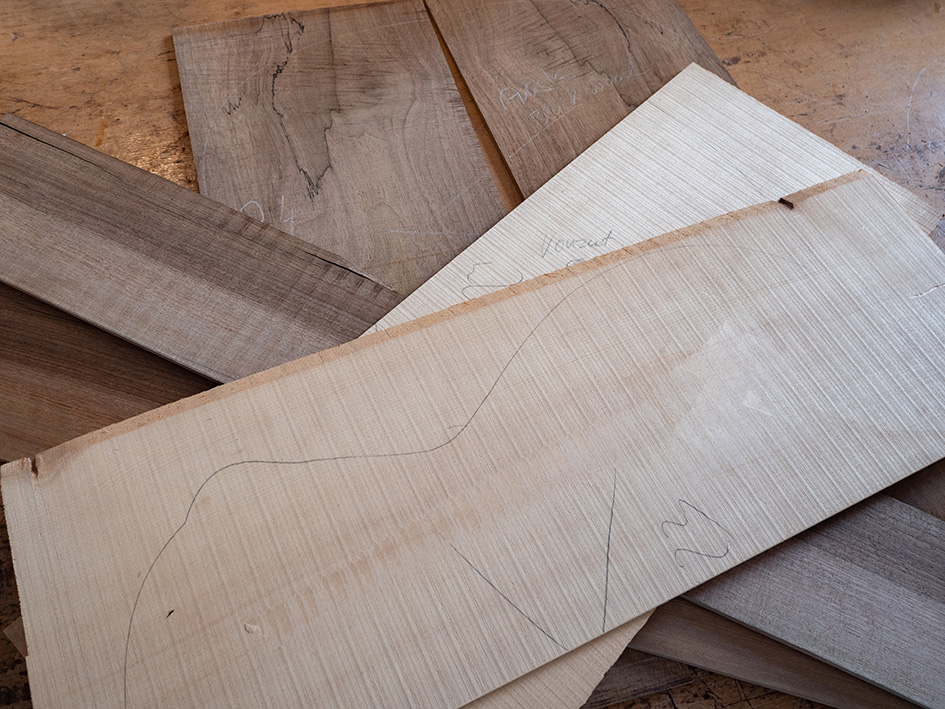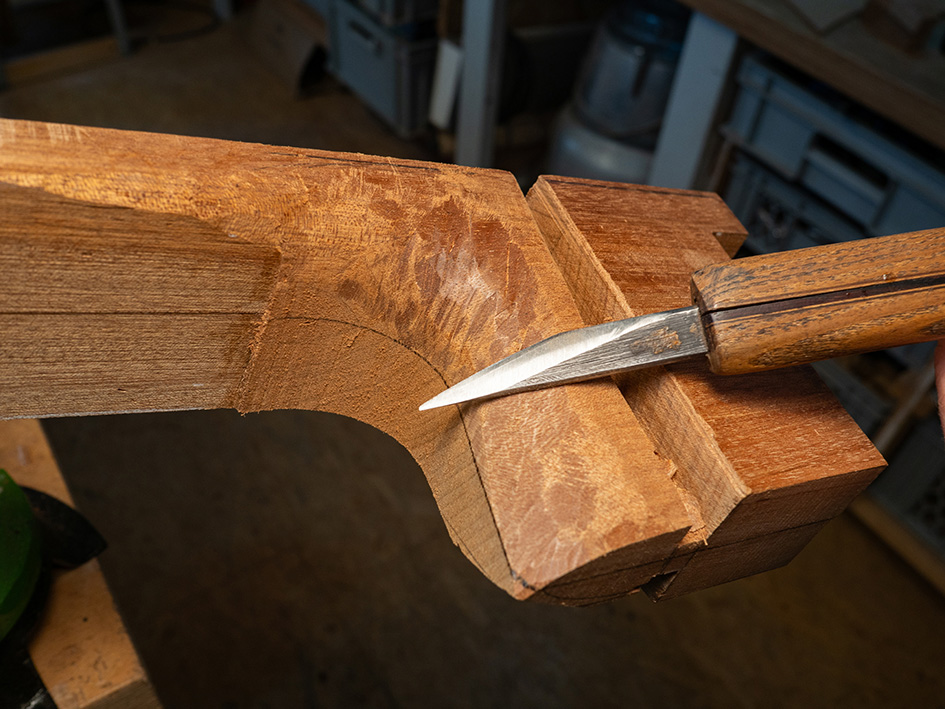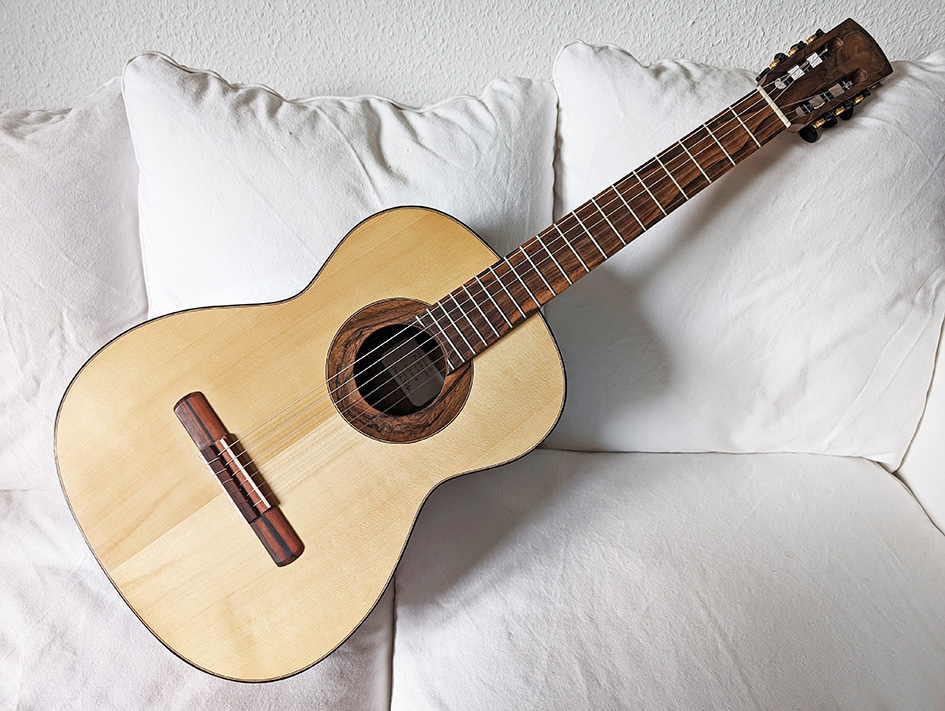Felix Reuter builds guitars out of passion. He has been teaching the traditional craft in workshops for over 20 years.
With his guitar-making studio, Felix Reuter is one of the veterans of Cologne’s Sülz district. Classical concert guitars, steel-string guitars and models with more unusual designs adorn the premises of the old corner house. The native of Euskirchen built most of the instruments himself. With skilled craftsmanship and great attention to detail. Occasionally, Felix restores or repairs historical and outdated guitars. This all takes place in the studio workshop. This is where the real music is played – especially in guitar making courses.

A warm light illuminates the workshop. It smells of wood and glue. Saws, planes, scraper blades and chisels – all the tools have their fixed place. Guitar molds and bending machines leave no doubt as to what is being built here. Large wooden tables with vices serve as workstations. Four, to be precise. Because Felix is rarely alone in the workshop. Under his guidance, even amateurs can learn the art of guitar making. The offer is popular: “There are waiting lists and some come back after the first guitar,” says Felix. I also became aware of him through this offer. Instead of (once again) buying a new guitar, which I honestly don’t need, I am now paying for what will turn out to be a great experience over the coming months.
Under the guidance of the experienced guitar maker, I will bring a concert guitar to life according to my own ideas. “You need to allow for around 100 hours,” says Felix, looking at the workload ahead. He explains the individual steps. Cutting the wood, sanding, planing, bending the sides, carving the neck and, and, and… I have a slight feeling of being overwhelmed, which Felix manages to push aside with a smile and an “everything will be fine”. After more than 20 years of building guitars, he takes a very relaxed view of things.
Lateral entry into guitar making
In the 1980s, Felix initially studied music education with guitar as his main subject because he was unable to get an apprenticeship as a luthier. Through his studies, he nevertheless found his way into the craft: “My lecturer Prof. Ulrich Müller introduced me to the art of guitar making.” He built his first guitar in 1986, a subject he would not let go of later. Books on the history of guitar making and the different types of construction inspired Felix to come up with his own ideas. In 2003, he finally opened his studio so that he could concentrate fully on building guitars.

Felix accompanies the first work steps, the sanding, sawing and planing of the body parts, with impressive calm. Like many of his workshop guests, I have never worked with a planer, scraper or chisel before. It takes a lot of practice to fully exploit the potential of the tools. After a few hours, I get a feel for it. How much material is removed? In which direction does it work better? Slowly but surely, I get used to the shape of the individual components. The most impressive example is the neck. Many people have particular respect for the arched foot on the body. But the carving work quickly teaches me that it will turn out well, as Felix repeatedly confirms.
Guitar making like 200 years ago
Felix works according to the traditional Spanish construction method. This means that the top and back are first fitted with stabilizing beams. The already bent sides are also given reinforcing bindings. The next steps start with the top. We glue the neck to the inside, followed by the sides. Only at the end does the back close the guitar body. The guitar now has its shape. However, there is still a lot to do before I can string it. “This is about the halfway point,” says Felix, giving an outlook. There is still a lot of finishing work to do.

Felix is happy to help with a few crucial work steps because it is important to him that everyone goes home with a good instrument. For example, he mills the edges of the body so that the bindings fit precisely. He also pre-cuts the slots for the frets with millimeter precision so that every note sits where it belongs.
As I get closer and closer to my goal, the manual work becomes a little easier. At the same time, I realize that precision and cleanliness are now all the more important. Small mistakes are and remain visible if you don’t correct them straight away. “You have to work precisely. Only then will it be good,” jokes Felix. Of course, I’ll see that he’s right at one point or another. Fortunately, minor slips can be almost completely corrected in most cases. One example: The guitar base has slots into which the sides are clamped. I had sawn one of them a little too diagonally. It left an unsightly gap. Felix remains relaxed: “Just put a piece of veneer and seal it with sanding dust and superglue.” I’m skeptical, but it works perfectly.
Shellac layer by layer
I find my biggest challenge in polishing shellac. It sounds so simple. A piece of woolen fabric wrapped in a soft cotton cloth is soaked in shellac. It is applied in combination with some oil. In circular movements over the wood, again and again. The varnish gradually builds up. I become more confident. Finally, the shellac is relatively well distributed – better than I had feared. Again, what counts for me is that I did it myself, not the objectively perfect result.
The varnished guitar is now ready for the final steps. Felix helps once again to ensure that the bridge is glued on correctly. I file the bone pieces for the nut and the saddle to the correct final dimensions. Subsequent reworking is not unusual here and in my case necessary. The string action is still too high for me.

In the end, everything really does turn out well. I am holding a classical guitar in my hands that is unlike any other. It is the personal result of craftsmanship in which – as predicted – I was allowed to immerse myself for around 100 hours. The individual design elements will always remind me of the individual work steps. Even one or two minor mistakes, which are inevitable during such a time, are part of it. All of this makes the guitar a very individual instrument. I give it the designation CG1-ABW (Classical Guitar 1 – Australian Blackwood). Friends ask if it sounds better than my other guitars. My strongly subjective feeling says yes, of course. Objectively, too, everything fits. The woods have a lot of resonance, the strings sound pleasant and powerful at the same time. But the decisive point remains: it was about the unique experience of building an instrument myself. Ok, it won’t be unique, because after the guitar is before the guitar. I’ll be back: I could really do with another acoustic guitar.